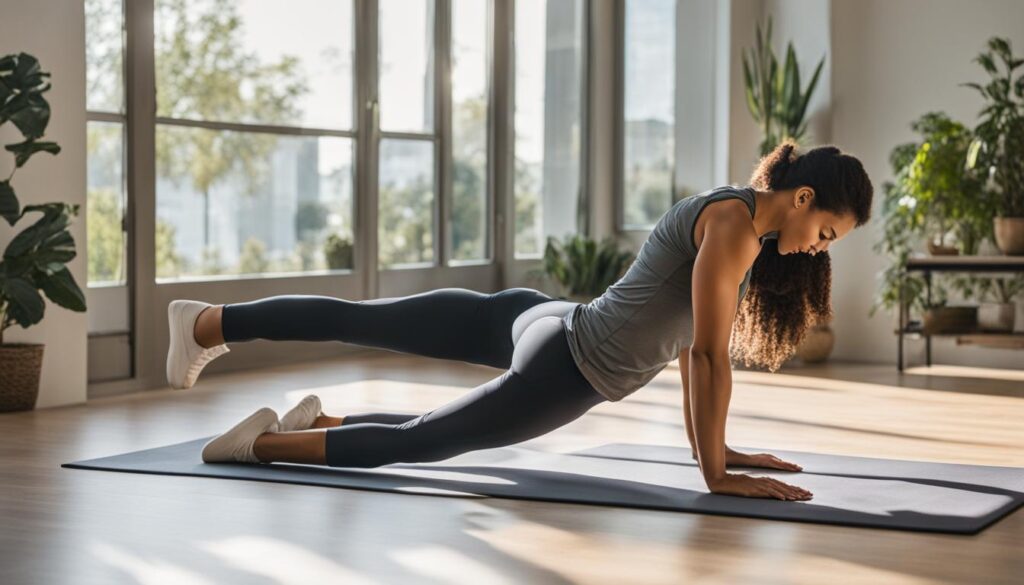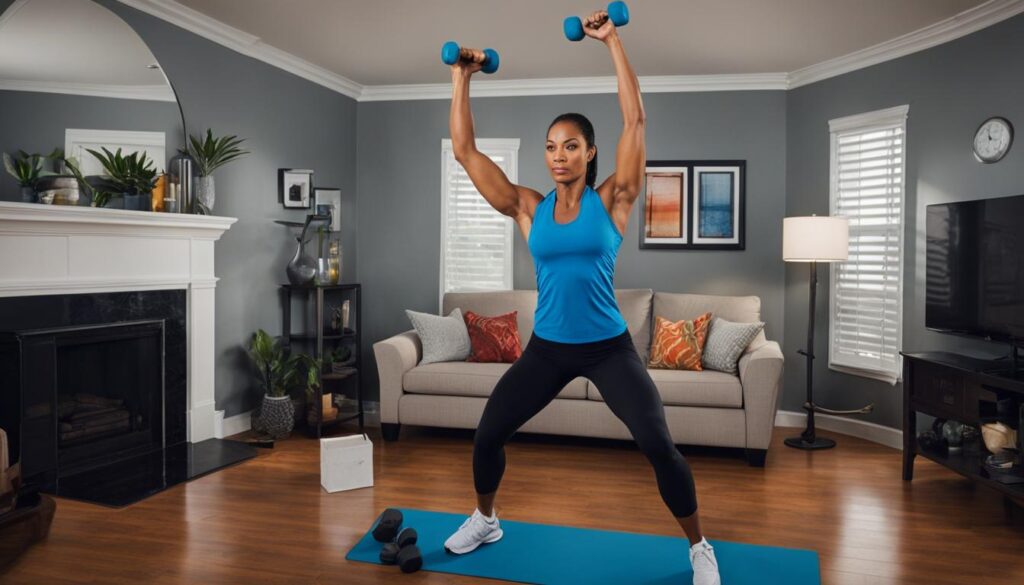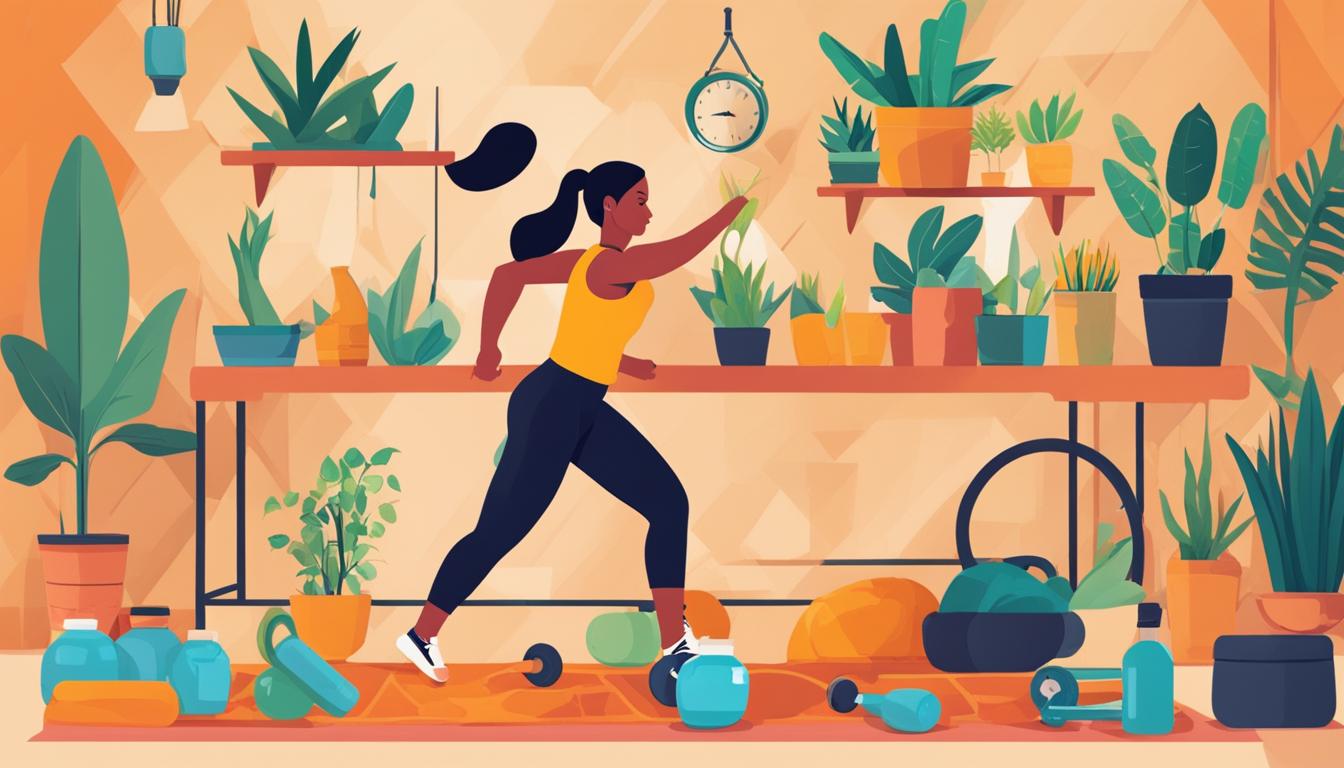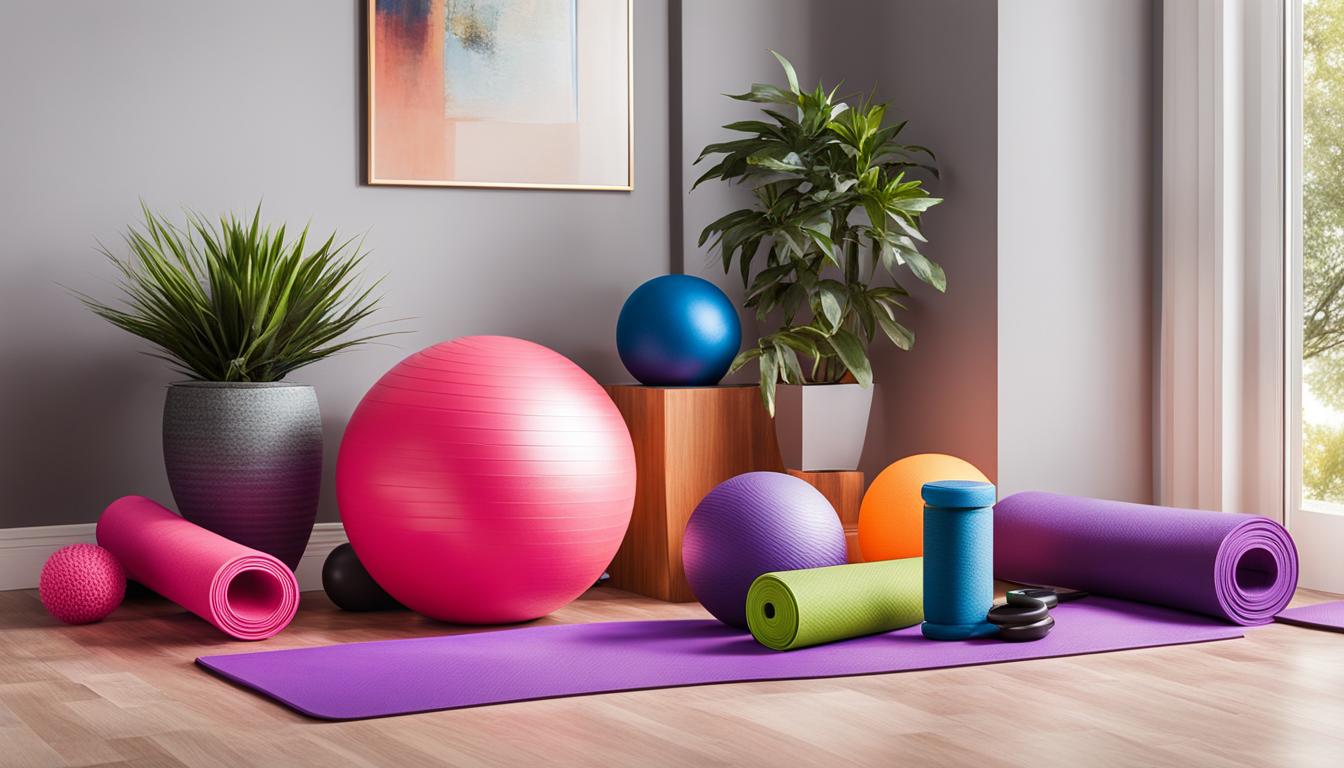Embarking on a path to self-improvement often begins with enhancing your physical well-being. In today’s busy world, it’s not always possible to make it to the gym, but that shouldn’t hinder your progress. With at-home fitness routines, you can sculpt a fitter, healthier version of yourself without stepping outside your front door. Whether you’re squeezing in a home workout between meetings or dedicating a Sunday morning to your fitness, these versatile and effective workout routines can be seamlessly integrated into your daily life.
Let’s transform the control you have over your health by making your home a sanctuary of fitness. These home exercise programs are designed to be accessible, requiring little to no equipment while motivating you to stay fit at home. By tapping into the power and diversity of digital resources, including expert-led workout videos and personalized online coaching, you’re well-equipped to take on this health-focused quest.
Key Takeaways
- Maximize your time and minimize excuses with customizable at-home fitness routines.
- Discover the convenience and simplicity of home workouts that fit into your schedule.
- Boost your health with tailored workout routines that require no special equipment.
- Adopt a sustainable fitness routine that encourages consistency and progress.
- Join the countless individuals who have streamlined their path to wellness through dependable home exercise programs.
- Focus on self-care by taking actionable steps to stay fit at home.
The Benefits of Embracing At-Home Fitness Routines
Discovering the advantages of at-home fitness extends beyond simple convenience. It’s an empowering path to personal wellness that adapts to your lifestyle and space. Whether you’re engaging in a high-energy home fitness challenge or following a set of targeted workout routines, the flexibility offered by exercising at home can significantly enhance your quality of life.
Convenience of Exercising at Home
When you exercise at home, you’re in charge of your schedule. No more rushing to make it to a class or battle for equipment. Your living room, bedroom, or any space you deem fit turns into your gym. This unparalleled convenience means your fitness-at-home efforts happen on your terms, fitting seamlessly into your busy life.
Personalized Workout Sessions
Digital technology brings tailored workout videos to your fingertips, allowing for personalized fitness sessions. Platforms offer a range of fitness routines designed for different levels of ability and goals, from gentle yoga flows to intensive HIIT sessions, ensuring your home workouts never become monotonous.
Lower Costs and Time Saving
The financial and time benefits are substantial, too. Gym memberships and commute times are replaced with instant access to high-quality workouts at no additional cost. A workout routine at home cuts out the middleman, delivering the results you want with the resources you have.
| At-Home Fitness | Traditional Gym |
|---|---|
| A one-time investment in equipment or no cost for bodyweight exercises | Monthly membership fees |
| Zero travel expenses | Cost of travelling to and from the gym |
| Flexible schedule aligning with personal commitments | Scheduled class times; potential wait for equipment |
| Privacy and comfort of your own space | Public space with potential for crowding |
Establishing Your Home Workout Space
Creating an inviting and motivational space for your at-home fitness routines is pivotal for staying committed to your wellness journey. There’s no need for a fully-equipped gym; a simple spot that you associate with health and endurance will suffice. This will become the sacred ground where you’ll push through each workout routine and tackle your home fitness challenge.
Start by identifying an area that is free of clutter, perhaps a corner of your bedroom or some unused space in your living room. This should be a zone where distractions are minimized, enabling you to focus on your exercise regimen. Remember, the aesthetic and functionality of your home exercise program are yours to tailor.
- Clear out unnecessary items and ensure there’s enough room for movement.
- Designate storage for any equipment you might use, even if it’s minimal.
- Consider the lighting and ventilation of your space to maintain a comfortable environment.
Understanding that your workout space is an evolving project is key. As you proceed, you may find new ways to optimize the area, making it even more conducive to your goal of staying fit at home. This personal fitness nook is where you’ll sweat, grow, and overcome your physical limits one day at a time.
Essential Gear for Effective Home Workouts
Embarking on a home fitness challenge requires having the right tools at your disposal. Whether you’re crafting personalized workout routines or following along with pre-planned fitness routines, certain pieces of equipment can make your efforts to stay fit at home more productive and enjoyable.
Selecting the Right Exercise Equipment
When it comes to home workouts, the selection of gear can be just as important as the exercises you perform. To get the most out of your fitness routines, consider investing in versatile equipment like dumbbells, which offer a range of weight options for strength training, or resistance bands, known for their ability to add intensity to both upper and lower body workouts. For those who enjoy callisthenics, a sturdy chin-up bar can become the cornerstone of your regimen. These fundamental pieces not only amplify your workout routines but also help in maintaining consistency.
Making Do with Household Items
Let’s face it, not everyone is ready to splurge on gym equipment, and that’s perfectly fine. You’ll be pleased to hear that you can still get a rewarding workout by utilizing household items. A pair of milk jugs filled with water or sand can easily substitute for kettlebells or weights. Similarly, a sturdy chair or couch can be used for exercises like tricep dips or inclined push-ups. Getting creative with what you have at home can be both a fun and an effective way to engage in your fitness routine without breaking the bank.
Organization and Storage Solutions
Maintaining an organized space is key to a successful home fitness routine. Proper storage solutions will not only keep your workout area tidy but also make it easier to transition between exercises, helping you maintain the flow of your routine. Consider using storage bins or shelves dedicated to your workout equipment. A clear space means a clear mind, allowing you to focus on your workout routines and stay fit at home without unnecessary distractions.
Warming Up and Cooling Down: A Crucial Component of At-Home Workouts
Embarking on your at-home fitness routine isn’t just about the workout itself; it’s about preparing your body and mind for the physical challenge ahead and ensuring your muscles recover effectively afterwards. Warm-ups and cool-downs are the bookends of your home exercise program, promoting better performance and reducing the risk of injury.
The Importance of Pre-Workout Warm-Ups
Think of warm-ups as the appetizer to your home workout’s main course. They gradually raise your body temperature and increase blood flow to your muscles, making them more pliable and ready to tackle the fitness routines ahead. By performing dynamic movements, you’re sending a message to your body that it’s time to transition from rest to activity.
Dynamic Stretches to Incorporate
Dynamic stretches are ideal for engaging the muscles you’re about to use during your workout. These are not your hold-and-stretch poses—think fluid, controlled movements that mimic your upcoming exercises. Movements such as arm circles, leg swings, and torso twists are perfect for getting every part of your body in motion.

Post-Workout Cool Down Techniques
After an invigorating session of home workouts, cool-down exercises gently bring your heart rate down and help prevent muscle stiffness. Stretching, breathing exercises, and gradual reduction of physical activity are key in helping your body transition back to its resting state. This not only aids in recovery but also helps you feel more refreshed post-workout.
| Warm-Up Activity | Benefit | Duration |
|---|---|---|
| Jumping Jacks | Activates full body | 5 minutes |
| Air Punches | Engages upper body and core | 3 minutes |
| Bodyweight Squats | Prepares lower body and glutes | 4 minutes |
| Dynamic Stretches | Improves range of motion | 5-10 minutes |
Integrating these warm-up and cool-down strategies into your fitness routines elevates the effectiveness of any at-home fitness routine you undertake. So, take those extra minutes before and after your workouts seriously, and your body will thank you in the long run!
At-Home Fitness Routines to Kickstart Your Journey
Embarking on a fitness regimen from the comfort of your home is a commendable and convenient way to achieve your health goals. Whether you have a tight schedule or prefer the privacy of your own space, at-home fitness routines provide the perfect blend of flexibility and effectiveness. If you’re new to home workouts, fear not. There is a plethora of workout routines designed for those just starting; they’re simple, require no equipment, and importantly, they’re fun. Let’s dive into some popular programs that promise to make your home fitness challenge engaging and fruitful.
With a variety of workout plans available, it’s easy to get overwhelmed. Below is a curated selection of home workouts that cater to different fitness levels and interests. Ranging from the “5×5 Living Room Lifts” to more unique routines like the “Dancing Queen Cardio”, there’s something for everyone. Remember, the key to fitness is consistency; find a routine you enjoy, and stick to it!
| Program Name | Duration | Intensity Level | Equipment Needed | Fitness Focus |
|---|---|---|---|---|
| 5×5 Living Room Lifts | 25 minutes | Beginner | None | Strength Training |
| Dancing Queen Cardio | 30 minutes | Moderate | None | Cardiovascular Health |
| Power Pilates | 45 minutes | Intermediate | Mat | Flexibility and Core Strength |
| Attack of the Angry Birds | 20 minutes | Advanced | None | High-Intensity, Full Body Workout |
While structured programs are an excellent way to get started, don’t underestimate the power of freestyle fitness routines. Sometimes, the best workout is the one you create on the fly, mixing and matching exercises that you love. Turn on some music and sequence moves like push-ups, squats, burpees, and lunges into a custom, full-body home fitness challenge.
- Start with a 5-minute light jog in place to get your heart rate up.
- Rotate through bodyweight exercises, spending 1 minute on each.
- Include short, 30-second rest periods after every 3 exercises.
- Increase the intensity by speeding up reps or adding jump elements.
Remember, your fitness journey at home is your unique path. Feel free to explore different workout routines and movements that speak to you and your body’s needs. There’s no one-size-fits-all approach in fitness, and that’s the beauty of it. Embrace the process, sweat it out, and celebrate every milestone on your road to better health.
From Beginner to Advanced: Scaling Your Home Workouts

Embarking on an at-home fitness journey doesn’t mean you’re confined to one level of intensity or complexity. Whether you’re just starting out or you’ve been sweating it out in your living room for months, your home workouts can evolve as you do. As your grasp on workout routines strengthens, and burpees become less daunting, the real magic of a home exercise program reveals itself – the ability to tailor your regimen for continual progress.
You may begin with fundamental moves like walking lunges and dumbbell rows, but as your body adapts, you can seamlessly transition into more demanding exercises. Imagine yourself mastering one-legged squats and confident enough to tackle chin-ups – each milestone in your home fitness challenge is a testament to your dedication and growth.
- Initial workouts focusing on form and endurance
- Introduction of weights and resistance bands for added challenge
- Progression to compound movements combining strength and cardio
- Advanced variations like plyometrics and unilateral exercises
The beauty of at-home fitness routines lies in their flexibility. You don’t need a gym’s worth of equipment or a personal trainer shouting encouragement – with a well-crafted home exercise program and some grit, you’ll find yourself conquering workouts you once thought were beyond your reach. Always remember that the secret to effective fitness is consistency, coupled with the willingness to push just a bit further each time.
“Every next level of your life will demand a different you.”
Don’t hesitate to take that statement to heart, especially when it comes to your workout routines. With the support of online resources and virtual communities, scaling your routine from beginner to advanced is an achievable and deeply rewarding journey. So roll out your mat, lace up your sneakers, and get ready to surge forward in your at-home fitness endeavour.
Building Muscle and Losing Weight with No Equipment
If you’re looking to build muscle and achieve weight loss without the luxury of a gym, your own body is your most powerful tool. Bodyweight exercises, combined with high-intensity interval training (HIIT), and isometric holds, offer a powerful trifecta for fat loss and core strength enhancement right from the comfort of your home. Let’s explore how each method can catapult you towards your fitness goals.
Utilizing Bodyweight Exercises for Muscle Gain
Bodyweight exercises are a cornerstone of fitness for anyone keen to build muscle. They are versatile and can be performed anywhere, at any time, with progressions that make them suitable for all fitness levels. Whether you’re doing push-ups, squats, or pull-ups, these exercises engage multiple muscle groups, facilitating muscular development and functional strength.
High-Intensity Interval Training for Fat Loss
HIIT is formidable in the realm of fat loss. Short bursts of intense exercise followed by rest periods not only burn calories rapidly but also keep the metabolism elevated long after your workout is over. This ‘afterburn effect’ is instrumental in shedding fat and sculpting a lean physique.
Isometric Holds for Core Strength
Further enhancing your fitness regimen, isometric holds like planks and wall sits focus on improving core strength. These exercises require you to engage your muscles against immovable forces, which is highly beneficial for muscular endurance and stability. Incorporating these exercises into your routine can lead to impressive gains in your overall muscular control and strength.
Now, let’s break down a sample workout schedule that you can follow at home. Remember, consistency is key, and these exercises should be performed with proper form to maximize effectiveness and avoid injury.
| Day | Exercise | Sets x Reps | Details |
|---|---|---|---|
| Monday | Push-ups | 3 x 12 | Standard and wide-hand positions |
| Tuesday | Squats | 4 x 15 | Bodyweight, focus on depth |
| Wednesday | Plank Holds | 3 x 45 sec | Focus on core engagement |
| Thursday | Burpees | HIIT, 20 sec on, 40 sec off | Total of 10 minutes |
| Friday | Pull-ups | 3 x 8 | Use a sturdy doorframe bar |
| Saturday | Wall Sits | 3 x 1 min | Press back flat against the wall |
| Sunday | Rest | – | Focus on recovery |
Remember, while no equipment is needed, the intensity and your willingness to push through your comfort zone are what will truly drive your transformation. Embrace these practices, stay consistent, and watch as you build muscle and enhance your weight loss journey with each passing week.
Tracking Progress and Staying Motivated Without the Gym
Embarking on a home exercise program offers flexibility but requires a solid strategy to maintain motivation and measure success. Smartly tracking progress and pursuing fitness goals with the help of a workout schedule, fitness apps, and online communities can keep you inspired and accountable.
Setting Realistic Fitness Goals
Firstly, pin down your short-term and long-term fitness goals. These could range from losing a certain amount of weight to increasing strength in particular muscle groups or perhaps completing a set number of workouts each week. Be specific and reasonable to keep these goals within reach, ensuring they map a path to your broader ambitions for health and fitness.
Creating a Workout Routine Schedule
Consistency is key in any fitness journey. That’s why having a well-structured workout schedule is vital. Planning your workouts not only helps in fostering discipline but also allows you to manage your time efficiently. Break your goals down into weekly increments and assign exercises to each day, being mindful to include rest days for recovery.
Applying Fitness Apps and Online Communities for Support
In today’s digital age, a multitude of fitness apps offer comprehensive progress tracking—from logging workouts to analyzing performance. They’re also a great source for finding new routines and staying fresh with your home exercise program. Moreover, getting involved with online communities can introduce you to a network of peers who share similar goals, offering encouragement, competition, and camaraderie. Group challenges and success stories fuel your drive, especially during days when motivation wanes.
Implement these strategies, and you’ll find yourself forging ahead on the path to fitness without ever needing to step foot in a gym. Let technology and community become your allies in this at-home journey to better health.
Integrating Fitness with Lifestyle for Long-term Health
Incorporating a health-centric approach into your lifestyle is not just about the physical exercises you do; it extends into every aspect of your daily routine. Achieving long-term health involves a strategic blend of activities that support both the body and mind. Let’s delve into how a balanced diet, mindfulness, and seamlessly interwoven daily activities contribute to your wellness journey.
Maintaining a Balanced Diet for Optimal Results
When it comes to fueling your body for both day-to-day energy and workout endurance, maintaining a balanced diet is imperative. A diet rich in whole foods, like vegetables, fruits, lean proteins, and whole grains, delivers the nutrients necessary for muscle recovery and consistent energy levels. Below is a general guide to help you structure your nutrient intake that can be tailored to fit your specific fitness goals.
| Nutrient | Benefits | Sources |
|---|---|---|
| Protein | Muscle repair and growth | Chicken, fish, tofu, legumes |
| Carbohydrates | Energy | Whole grains, fruits, vegetables |
| Fats | Hormone function, energy | Avocados, nuts, olive oil |
| Vitamins & Minerals | Overall health support | Dark leafy greens, berries, nuts |
| Water | Hydration, detoxification | Water, herbal teas, water-rich foods |
Incorporating Mindfulness and Recovery Days
Emphasizing mindfulness and scheduling recovery days are as important as the workouts themselves. Mindfulness techniques, like meditation and deep-breathing exercises, can enhance mental clarity and reduce stress, aligning your mental state with your physical pursuits. Recovery, meanwhile, is essential in preventing overtraining and injury, ensuring your body has time to heal and strengthen. Honouring this balance supports sustainable fitness gains.
Aligning Workout Routines with Daily Activities
Merging your workout routines with daily activities is a practical way to stay active without feeling overwhelmed. Look for opportunities to add more movement to your day; this could mean taking a brisk walk during lunch breaks, opting for stairs over elevators, or even doing stretches while watching TV. Aligning these activities promotes a more vibrant lifestyle and seamlessly supports your fitness ambitions.
Remember, the key to long-term health is not in drastic, short-lived overhauls but in the small, consistent choices you make every day. By remaining mindful of your diet, incorporating recovery into your routine, and finding creative ways to integrate fitness into your life, you’re setting yourself up for a lifetime of well-being.
Conclusion
Embracing at-home fitness routines has proven to be more than just a convenient alternative to gym workouts; it’s a sustainable and adaptable way to sculpt and maintain your ideal physique. The journey to a better, healthier you don’t require expensive memberships or commuting to a fitness centre. Instead, it starts in the comfort of your living room or any designated space, where you have the freedom to tailor your fitness routines to your personal goals and preferences.
With the right approach—incorporating essential warm-ups, employing the correct gear, and ensuring proper cool-downs—your home workouts can become a potent tool for achieving and surpassing your fitness aspirations. The beauty of exercising at home lies in its simplicity and the ability to integrate your workout regime seamlessly into your daily life, ensuring that staying active becomes a natural part of your routine.
As we conclude, remember that the key to unlocking the full potential of at-home workouts is consistency and the willingness to evolve your routines as your strength improves. Your fitness journey is uniquely yours, and with the wealth of resources available today, creating an effective at-home workout routine has never been more attainable. Here’s to building a healthy, balanced lifestyle around fitness routines that are not only effective but enjoyable and perfectly suited to your life’s rhythm.
FAQ
What kind of exercises can I do at home to stay fit?
You can perform a variety of exercises at home that require no equipment, such as bodyweight exercises (push-ups, squats), high-intensity interval training (HIIT), yoga, and stretching routines. Additionally, workout videos and online coaching can provide structured home workouts to suit your fitness level.
How can at-home fitness routines save me time and money?
At-home workouts eliminate the travel time to a gym and can reduce the need for expensive gym memberships. Plus, exercising at home means you can fit your workouts around your schedule conveniently.
What equipment do I need for an effective home workout?
To enhance your at-home workouts, consider using basic equipment like dumbbells, resistance bands, and mats. If you’re on a budget, household items like water bottles or canned goods can act as substitutes for weights. Remember, many effective exercises require no equipment at all.
How can I set up my own home workout space?
Choose a designated area where you feel comfortable and motivated, whether it’s a cleared space in your living room or a dedicated corner in your bedroom. This space should allow you to move freely and safely while doing your exercises.
Why is warming up and cooling down important for home workouts?
Proper warm-ups prepare your body for exercise and can help prevent injury. They increase your heart rate and loosen up your muscles and joints. Cooling down helps to gradually lower your heart rate and can reduce muscle stiffness and soreness post-workout.
Are there at-home fitness routines that can accommodate my busy schedule?
Absolutely! Many quick yet effective workout routines can fit into a busy schedule, such as 20-minute HIIT sessions or guided yoga practices that you can do right in your living room.
Can I still build muscle and lose weight without going to the gym?
Yes, you can build muscle and lose weight at home using bodyweight exercises, such as planks and lunges for core strength, and HIIT routines for fat loss. These exercises use your own body weight for resistance and can be very effective when paired with a balanced diet.
How do I stay motivated to continue my at-home workouts?
Staying motivated at home involves setting achievable fitness goals, maintaining a consistent workout schedule, and possibly using fitness apps to track your progress. Also, becoming a part of an online fitness community can provide the necessary support and encouragement.
What does integrating fitness into my lifestyle mean?
Integrating fitness into your lifestyle means including physical activity into your daily routine, like cycling to work, taking the stairs, or performing desk stretches. It also involves adopting a balanced diet and giving yourself time for mindfulness and recovery.
How do I know which at-home workout is right for me?
Start by assessing your current fitness level and identify your personal health and fitness goals. Consider trying different types of workouts through online classes or apps to find what you enjoy. Personalized online coaching can also help design a home workout program tailored to your needs.





